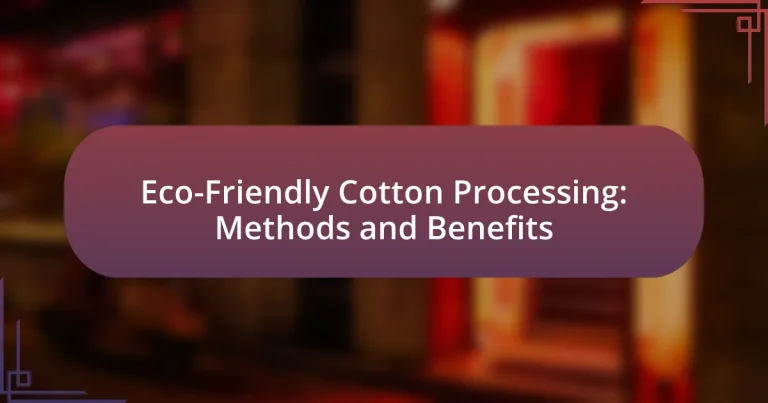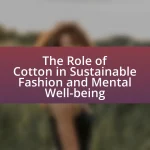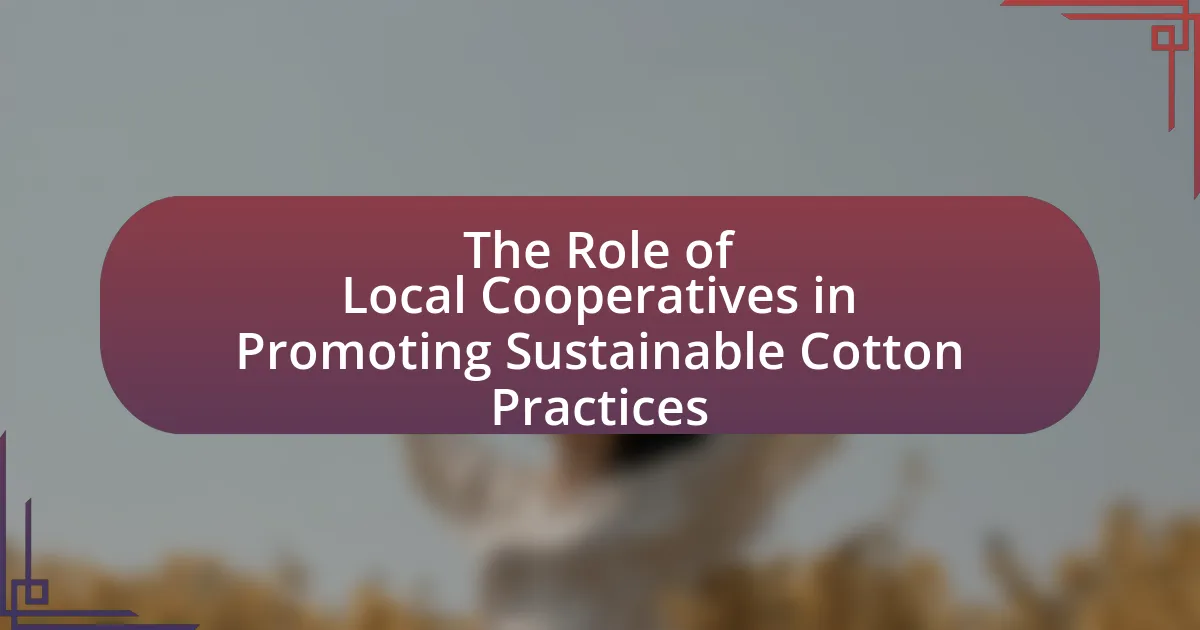Eco-Friendly Cotton Processing refers to sustainable methods of producing cotton that minimize environmental impact through organic farming practices, reduced chemical usage, and water-efficient techniques. This article outlines the differences between eco-friendly and conventional cotton processing, emphasizing the principles of sustainability, biodiversity promotion, and reduced carbon footprints. Key methods such as organic farming, natural pest control, and water-saving technologies are discussed, along with the environmental, economic, and social benefits of adopting eco-friendly practices. Additionally, the article addresses the challenges faced by farmers in transitioning to these methods and highlights the importance of education and community engagement in promoting sustainable cotton production.

What is Eco-Friendly Cotton Processing?
Eco-Friendly Cotton Processing refers to the methods used to produce cotton in a sustainable manner that minimizes environmental impact. This processing typically involves organic farming practices, which avoid synthetic pesticides and fertilizers, and utilize natural alternatives to promote soil health and biodiversity. Additionally, eco-friendly processing includes water-efficient techniques, such as rain-fed irrigation and recycling water, which significantly reduce water consumption compared to conventional cotton farming. According to the Textile Exchange, organic cotton farming uses 91% less water than conventional methods, highlighting the environmental benefits of eco-friendly practices.
How does eco-friendly cotton processing differ from conventional methods?
Eco-friendly cotton processing differs from conventional methods primarily in its use of sustainable practices that minimize environmental impact. Conventional cotton processing often involves synthetic pesticides and fertilizers, which can lead to soil degradation and water pollution. In contrast, eco-friendly methods utilize organic farming techniques, such as crop rotation and natural pest control, which enhance soil health and reduce chemical runoff. Additionally, eco-friendly processing typically employs less water and energy, utilizing techniques like rainwater harvesting and renewable energy sources, thereby lowering the carbon footprint associated with cotton production. This approach not only conserves resources but also promotes biodiversity and supports local ecosystems.
What are the key principles of eco-friendly cotton processing?
The key principles of eco-friendly cotton processing include sustainable farming practices, reduced chemical usage, water conservation, and energy efficiency. Sustainable farming practices involve crop rotation and organic farming methods that enhance soil health and biodiversity. Reduced chemical usage emphasizes the avoidance of harmful pesticides and fertilizers, which can contaminate water sources and harm ecosystems. Water conservation techniques, such as rainwater harvesting and drip irrigation, minimize water waste during cultivation and processing. Lastly, energy efficiency focuses on using renewable energy sources and optimizing machinery to lower carbon emissions during cotton processing. These principles collectively contribute to a more sustainable and environmentally friendly cotton industry.
How does sustainability play a role in eco-friendly cotton processing?
Sustainability is integral to eco-friendly cotton processing as it minimizes environmental impact while promoting social responsibility. Eco-friendly cotton processing employs methods such as organic farming, which avoids synthetic pesticides and fertilizers, thereby preserving soil health and biodiversity. According to the Global Organic Textile Standard, organic cotton farming can reduce water usage by up to 90% compared to conventional methods. Additionally, sustainable practices in cotton processing include using renewable energy sources and implementing water recycling systems, which further decrease carbon footprints and resource depletion. These practices not only contribute to environmental conservation but also support fair labor practices, ensuring that workers receive fair wages and safe working conditions.
Why is eco-friendly cotton processing important?
Eco-friendly cotton processing is important because it significantly reduces environmental impact and promotes sustainable agricultural practices. Traditional cotton processing often involves harmful chemicals and excessive water usage, leading to soil degradation and water pollution. In contrast, eco-friendly methods utilize organic farming techniques, which minimize pesticide use and conserve water, thereby protecting ecosystems. According to the Textile Exchange, organic cotton farming uses 91% less water and emits 46% less greenhouse gas compared to conventional cotton farming. This evidence underscores the necessity of eco-friendly cotton processing in fostering a healthier planet and supporting sustainable livelihoods.
What environmental impacts does conventional cotton processing have?
Conventional cotton processing has significant environmental impacts, primarily due to the extensive use of water, pesticides, and energy. The cultivation and processing of cotton require approximately 7,000 liters of water to produce just one kilogram of cotton, leading to water scarcity in many regions. Additionally, conventional cotton farming relies heavily on synthetic pesticides and fertilizers, which can contaminate soil and water sources, harming local ecosystems and biodiversity. Furthermore, the energy-intensive processes involved in ginning, spinning, and dyeing cotton contribute to greenhouse gas emissions, exacerbating climate change. These factors collectively highlight the detrimental environmental consequences associated with conventional cotton processing.
How does eco-friendly cotton processing contribute to reducing carbon footprints?
Eco-friendly cotton processing significantly reduces carbon footprints by utilizing sustainable farming practices and energy-efficient technologies. These methods include organic farming, which avoids synthetic fertilizers and pesticides, thereby lowering greenhouse gas emissions associated with chemical production. Additionally, eco-friendly processing often employs renewable energy sources, such as solar or wind power, which further decreases reliance on fossil fuels. According to a study by the Textile Exchange, organic cotton farming can reduce carbon emissions by up to 46% compared to conventional cotton farming. This combination of sustainable agricultural practices and energy-efficient processing contributes to a marked reduction in overall carbon footprints associated with cotton production.

What methods are used in eco-friendly cotton processing?
Eco-friendly cotton processing employs methods such as organic farming, natural pest control, and sustainable water management. Organic farming eliminates synthetic fertilizers and pesticides, promoting soil health and biodiversity. Natural pest control utilizes beneficial insects and organic substances to manage pests without harmful chemicals. Sustainable water management practices, including rainwater harvesting and drip irrigation, reduce water consumption and minimize environmental impact. These methods collectively contribute to a more sustainable cotton industry, aligning with environmental conservation goals.
What are the main techniques employed in eco-friendly cotton processing?
The main techniques employed in eco-friendly cotton processing include organic farming, water-efficient irrigation, and the use of natural dyes. Organic farming eliminates synthetic pesticides and fertilizers, promoting soil health and biodiversity. Water-efficient irrigation methods, such as drip irrigation, reduce water consumption by delivering water directly to the plant roots, minimizing waste. Additionally, natural dyes derived from plants and minerals are used instead of synthetic dyes, which can be harmful to the environment. These techniques collectively contribute to sustainable cotton production, reducing the ecological footprint of cotton processing.
How does organic farming contribute to eco-friendly cotton processing?
Organic farming contributes to eco-friendly cotton processing by utilizing sustainable agricultural practices that minimize environmental impact. This method avoids synthetic pesticides and fertilizers, which reduces soil and water contamination. According to the Organic Trade Association, organic cotton farming enhances soil health through crop rotation and composting, leading to improved biodiversity and reduced erosion. Additionally, organic farming practices often use less water compared to conventional methods, further supporting eco-friendly processing. These practices collectively contribute to a more sustainable cotton supply chain, aligning with environmental conservation goals.
What role do natural dyes play in eco-friendly cotton processing?
Natural dyes play a crucial role in eco-friendly cotton processing by providing a sustainable alternative to synthetic dyes, which often contain harmful chemicals. These natural dyes, derived from plants, minerals, and insects, minimize environmental impact by reducing water pollution and chemical waste associated with conventional dyeing processes. For instance, studies have shown that natural dyes can significantly lower the carbon footprint of textile production, as they require less energy and water during application compared to synthetic options. Additionally, the use of natural dyes supports biodiversity and promotes sustainable agricultural practices, as many dye sources can be cultivated without harmful pesticides or fertilizers.
How do water-saving technologies enhance eco-friendly cotton processing?
Water-saving technologies enhance eco-friendly cotton processing by significantly reducing water consumption during cultivation and processing stages. These technologies, such as drip irrigation and rainwater harvesting, optimize water usage, ensuring that cotton plants receive adequate moisture while minimizing waste. For instance, drip irrigation can reduce water usage by up to 60% compared to traditional methods, leading to lower environmental impact and improved sustainability. Additionally, the implementation of these technologies contributes to soil health and reduces the risk of water pollution, as less runoff occurs. This combination of reduced water use and improved environmental outcomes underscores the effectiveness of water-saving technologies in promoting eco-friendly cotton processing.
What are the benefits of using rainwater harvesting in cotton processing?
Rainwater harvesting in cotton processing offers significant benefits, including reduced water costs, improved sustainability, and enhanced crop quality. By collecting and utilizing rainwater, cotton processors can lower their reliance on municipal water supplies, which can be expensive and subject to restrictions. This practice also contributes to environmental sustainability by conserving groundwater resources and reducing runoff, which can lead to soil erosion and water pollution. Furthermore, using rainwater can improve the quality of cotton by providing a more consistent and natural water source, which is crucial for optimal growth and fiber development. Studies indicate that rainwater harvesting can lead to a 30% reduction in water costs for agricultural operations, demonstrating its economic viability alongside its ecological advantages.
How does drip irrigation improve sustainability in cotton farming?
Drip irrigation improves sustainability in cotton farming by significantly reducing water usage and enhancing crop yield efficiency. This method delivers water directly to the plant roots, minimizing evaporation and runoff, which conserves water resources. Research indicates that drip irrigation can reduce water consumption by up to 50% compared to traditional irrigation methods, while also increasing cotton yields by 20-30%. This efficient use of water not only supports sustainable farming practices but also helps in maintaining soil health and reducing the need for chemical fertilizers, as the targeted application of water encourages deeper root growth and nutrient uptake.

What are the benefits of eco-friendly cotton processing?
Eco-friendly cotton processing reduces environmental impact and promotes sustainability. This method minimizes the use of harmful chemicals, leading to healthier ecosystems and reduced water pollution. For instance, organic cotton processing uses natural pesticides and fertilizers, which can decrease soil degradation and enhance biodiversity. Additionally, eco-friendly practices often involve water-efficient techniques, conserving vital resources; studies indicate that organic cotton farming can use up to 91% less water compared to conventional methods. Furthermore, eco-friendly processing supports fair labor practices, improving the livelihoods of farmers and workers in the cotton industry.
How does eco-friendly cotton processing benefit the environment?
Eco-friendly cotton processing benefits the environment by significantly reducing water usage and chemical pollution. Traditional cotton farming consumes approximately 7,000 liters of water per kilogram of cotton, while eco-friendly methods can reduce this by up to 90% through techniques like rain-fed irrigation and organic farming practices. Additionally, eco-friendly processing minimizes the use of harmful pesticides and fertilizers, which can contaminate soil and waterways; for instance, organic cotton farming uses natural pest control methods, leading to a decrease in chemical runoff. This sustainable approach not only conserves vital resources but also promotes biodiversity and healthier ecosystems.
What are the advantages of reduced pesticide use in cotton processing?
Reduced pesticide use in cotton processing leads to improved environmental health and enhanced cotton quality. By minimizing chemical inputs, the soil and water systems experience less contamination, promoting biodiversity and healthier ecosystems. Furthermore, cotton produced with fewer pesticides often has higher market value due to consumer preference for organic and sustainably sourced products. Research indicates that organic cotton farming, which typically employs reduced pesticide use, can yield up to 20% higher prices in the market compared to conventionally grown cotton. This shift not only benefits farmers economically but also aligns with growing consumer demand for eco-friendly products.
How does eco-friendly cotton processing promote biodiversity?
Eco-friendly cotton processing promotes biodiversity by minimizing harmful agricultural practices and reducing chemical inputs. This approach encourages the use of organic farming methods, which enhance soil health and support diverse ecosystems. For instance, organic cotton farming often employs crop rotation and intercropping, which can increase habitat availability for various species. Additionally, the reduction of synthetic pesticides and fertilizers helps protect beneficial insects and microorganisms, thereby fostering a more balanced ecosystem. Studies have shown that organic farming can lead to a 30% increase in biodiversity compared to conventional methods, demonstrating the positive impact of eco-friendly practices on ecological diversity.
What economic benefits does eco-friendly cotton processing provide?
Eco-friendly cotton processing provides significant economic benefits, including reduced production costs and increased market demand. By utilizing sustainable practices, such as organic farming and efficient water usage, producers can lower expenses related to chemical inputs and water management. For instance, organic cotton farming can reduce costs by up to 30% compared to conventional methods due to lower input requirements. Additionally, the growing consumer preference for sustainable products has led to a 20% increase in market demand for eco-friendly cotton, allowing producers to command higher prices and improve profit margins. This shift not only supports local economies but also encourages investment in sustainable agricultural practices, further enhancing economic stability in cotton-producing regions.
How can eco-friendly cotton processing lead to cost savings for farmers?
Eco-friendly cotton processing can lead to cost savings for farmers by reducing input costs and increasing market access. Sustainable practices, such as organic farming and efficient water usage, lower the need for expensive chemical fertilizers and pesticides, resulting in direct savings. Additionally, eco-friendly cotton often commands higher prices in the market due to growing consumer demand for sustainable products, which can enhance farmers’ profit margins. Research indicates that farmers adopting organic practices can see a 20% increase in income compared to conventional methods, as reported by the Rodale Institute.
What market opportunities arise from eco-friendly cotton products?
Eco-friendly cotton products present significant market opportunities driven by increasing consumer demand for sustainable goods. The global organic cotton market was valued at approximately $1.5 billion in 2020 and is projected to grow at a compound annual growth rate (CAGR) of 10% through 2027, indicating a robust interest in environmentally friendly textiles. Additionally, brands that adopt eco-friendly practices can enhance their market positioning and attract environmentally conscious consumers, as 66% of global consumers are willing to pay more for sustainable brands. This trend is further supported by regulatory pressures and initiatives aimed at reducing environmental impact, creating a favorable landscape for businesses that prioritize eco-friendly cotton sourcing and production.
What social benefits are associated with eco-friendly cotton processing?
Eco-friendly cotton processing provides significant social benefits, including improved health outcomes for workers and communities. By reducing the use of harmful pesticides and chemicals, eco-friendly practices lower the risk of exposure to toxic substances, which can lead to health issues such as respiratory problems and skin diseases. Additionally, these practices often promote fair labor conditions, ensuring that workers receive fair wages and work in safe environments. According to the World Health Organization, reducing chemical exposure can lead to better overall community health, enhancing quality of life and productivity. Furthermore, eco-friendly cotton processing supports local economies by fostering sustainable agricultural practices that can lead to job creation and economic stability in rural areas.
How does eco-friendly cotton processing improve working conditions for farmers?
Eco-friendly cotton processing improves working conditions for farmers by reducing exposure to harmful chemicals and promoting sustainable agricultural practices. This method minimizes the use of pesticides and synthetic fertilizers, which can lead to health issues for farmers and their families. Studies indicate that organic cotton farming, which is a key aspect of eco-friendly processing, results in lower rates of respiratory problems and skin diseases among farmers due to decreased chemical exposure. Additionally, eco-friendly practices often include fair trade principles, ensuring that farmers receive fair wages and better working conditions, thus enhancing their overall quality of life.
What role does community engagement play in eco-friendly cotton initiatives?
Community engagement is crucial in eco-friendly cotton initiatives as it fosters collaboration between farmers, consumers, and organizations, leading to sustainable practices. Engaged communities can share knowledge about environmentally friendly farming techniques, which enhances the adoption of organic methods and reduces chemical usage. For instance, initiatives like the Better Cotton Initiative emphasize local involvement, resulting in improved farming practices and increased yields. Studies show that when communities actively participate, there is a 30% increase in the implementation of sustainable practices, demonstrating the effectiveness of community engagement in promoting eco-friendly cotton production.
What are the challenges in implementing eco-friendly cotton processing?
The challenges in implementing eco-friendly cotton processing include higher production costs, limited availability of organic cotton, and the need for specialized technology. Higher production costs arise from the use of sustainable practices and materials, which can deter farmers and manufacturers from adopting eco-friendly methods. Limited availability of organic cotton restricts supply chains, making it difficult for producers to source sufficient raw materials. Additionally, the need for specialized technology for processing and certification can create barriers for smaller producers who may lack the resources to invest in such advancements. These factors collectively hinder the widespread adoption of eco-friendly cotton processing practices.
What barriers do farmers face in transitioning to eco-friendly methods?
Farmers face several barriers in transitioning to eco-friendly methods, primarily including financial constraints, lack of knowledge, and limited access to resources. Financial constraints arise because eco-friendly practices often require upfront investments in new technologies or organic inputs, which can be prohibitive for many farmers. A study by the Food and Agriculture Organization indicates that transitioning to organic farming can incur costs that are 20-30% higher than conventional methods initially.
Additionally, a lack of knowledge about sustainable practices and their benefits can hinder farmers’ willingness to adopt eco-friendly methods. Research from the International Journal of Agricultural Sustainability highlights that many farmers are unaware of the techniques available to them or how to implement them effectively.
Lastly, limited access to resources such as organic seeds, eco-friendly pesticides, and training programs further complicates the transition. According to the World Bank, many farmers in developing regions lack the infrastructure and support systems necessary to facilitate this shift, making it difficult for them to adopt sustainable practices.
How can education and training support eco-friendly cotton processing?
Education and training can significantly enhance eco-friendly cotton processing by equipping stakeholders with knowledge about sustainable practices and technologies. Training programs can teach farmers about organic farming techniques, pest management, and soil health, which are essential for reducing chemical inputs and promoting biodiversity. Furthermore, educational initiatives can inform processors about energy-efficient technologies and waste reduction methods, leading to lower environmental impacts. Research indicates that regions with higher levels of agricultural education see improved adoption of sustainable practices, resulting in better environmental outcomes and increased profitability for farmers.
What best practices can enhance eco-friendly cotton processing?
Implementing organic farming practices enhances eco-friendly cotton processing by reducing chemical inputs and promoting biodiversity. Organic cotton is grown without synthetic pesticides or fertilizers, which minimizes environmental pollution and supports soil health. Additionally, utilizing water-efficient irrigation methods, such as drip irrigation, conserves water resources and reduces runoff. Research indicates that organic cotton farming can use up to 91% less water compared to conventional methods. Furthermore, adopting sustainable harvesting techniques, such as hand-picking, decreases damage to the cotton fibers and reduces energy consumption associated with mechanical harvesting. These practices collectively contribute to a more sustainable cotton industry, aligning with environmental conservation goals.
How can farmers effectively implement eco-friendly practices in their operations?
Farmers can effectively implement eco-friendly practices in their operations by adopting sustainable agricultural techniques such as crop rotation, organic farming, and integrated pest management. Crop rotation enhances soil health and reduces pest buildup, while organic farming minimizes chemical inputs, promoting biodiversity. Integrated pest management combines biological, cultural, and mechanical practices to control pests sustainably. Research indicates that these methods can lead to a 20-30% increase in yield while reducing environmental impact, as demonstrated in studies by the Food and Agriculture Organization.
What resources are available for promoting eco-friendly cotton processing?
Resources available for promoting eco-friendly cotton processing include certifications, educational programs, and financial incentives. Certifications such as Global Organic Textile Standard (GOTS) and OEKO-TEX provide guidelines for sustainable practices in cotton production and processing. Educational programs offered by organizations like the Better Cotton Initiative (BCI) equip farmers and manufacturers with knowledge on sustainable practices. Additionally, financial incentives from governments and NGOs, such as grants and subsidies for sustainable farming practices, encourage the adoption of eco-friendly methods. These resources collectively support the transition to environmentally responsible cotton processing.





